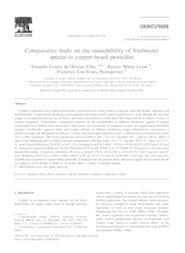Comparative study on the susceptibility of freshwater species to copper-based pesticides.
Comparative study on the susceptibility of freshwater species to copper-based pesticides.
Autoria: OLIVEIRA FILHO, E. C. de; LOPES, R. M.; PAUMGARTTEN, F. J. R.
Resumo: Abstract Copper compounds have been intentionally introduced into water bodies as aquatic plant herbicides, algicides and molluscicides. Copper-based fertilizers and fungicides have been widely used in agriculture as well. Despite the fact that copper is an essential element for all biota, elevated concentrations of this metal have been shown to affect a variety of aquatic organisms. Nonetheless, comparative studies on the susceptibility of different freshwater species to copper compounds have seldom been performed. This study was conducted to compare toxicity of copper-based pesticides (copper oxychloride, cuprous oxide and copper sulfate) to different freshwater target (Raphidocelis subcapitata, a planktonic alga and Biomphalaria glabrata, a snail) and non-target (Daphnia similis, a planktonic crustacean and Danio rerio, a fish) organisms. Test water parameters were as follows: pH=7.4 ± 0.1; hardness 44 ± 1 mg/l as CaCO3; DO 8?9 mg/l at the beginning and >4 mg/l at the end; temperature, fish and snails 25 ± 1 °C, Daphnia 20 ± 2 °C, algae 24 ± 1 °C. D. similis (immobilization), 48-h EC50s (95% CLs) ranging from 0.013 (0.011?0.016) to 0.043 (0.033?0.057) mg Cu/l, and R. subcapitata (growth inhibition), 96-h IC50s from 0.071 (0.045?0.099) to 0.137 (0.090?0.174) mg Cu/l, were the most susceptible species. B. glabrata (lethality), 48-h LC50s from 0.179 (0.102?0.270) to 0.854 (0.553?1.457) mg Cu/l, and D. rerio (lethality), 48-h LC50s 0.063 (0.045?0.089), 0.192 (0.133?0.272) and 0.714 (0.494?1.016) mg Cu/l, were less susceptible than Daphnia to copper-based pesticides. Findings from the present study therefore suggest that increased levels of copper in water bodies is likely to adversely affect a variety of aquatic species.
Ano de publicação: 2004
Tipo de publicação: Artigo de periódico
Unidade: Embrapa Cerrados
Palavras-chave: Alga, Cobre, Ecologia Aquatica, Fungicida, Herbicida, Poluição da Água, Toxicidade
Observações
1 - Por padrão são exibidas publicações dos últimos 20 anos. Para encontrar publicações mais antigas, configure o filtro ano de publicação, colocando o ano a partir do qual você deseja encontrar publicações. O filtro está na coluna da esquerda na busca acima.
2 - Para ler algumas publicações da Embrapa (apenas as que estão em formato ePub), é necessário ter, no celular ou computador, um desses softwares gratuitos. Sistemas Android: Google Play Livros; IOS: iBooks; Windows e Linux: software Calibre.
Acesse outras publicações
Acesse a Base de Dados da Pesquisa Agropecuária (BDPA) para consultar o acervo completo das bibliotecas da Embrapa.

